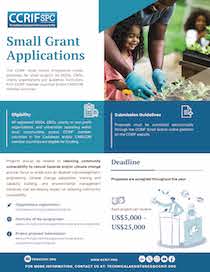Grand Cayman, 17 November, 2010 – Today, the Caribbean Catastrophe Risk Insurance Facility (CCRIF) completed insurance payments to the Governments of Barbados, Saint Lucia and St. Vincent & the Grenadines following the passage of Tropical Cyclone Tomas which passed close to these islands on 30 and 31 October, 2010. CCRIF released to each country 50% of their payouts on 7 November, seven (7) days after the storm’s passage – well before the end of the customary 14-day waiting period – to facilitate requests from the three countries. Prime Minister of St Vincent & the Grenadines, Hon Ralph Gonsalves said this early payment would facilitate “urgent restoration of services and clearing of the affected areas.”
The total payouts for the three countries were as follows: Barbados - US$8,560,247; Saint Lucia - US$3,241,613 and St Vincent & the Grenadines - US$1,090,388.
These three countries – along with 13 other Caribbean nations – have had catastrophe insurance for hurricanes and earthquakes with CCRIF since the inception of the Facility in 2007. CCRIF was formed at CARICOM’s request for a cost-effective risk transfer programme for member governments, and the insurance policies now form part of these countries’ disaster risk management frameworks.
CCRIF offers parametric insurance and therefore payouts can be calculated and made very quickly because there is no need to estimate damage after an event. Payouts for tropical cyclones are determined based on government losses calculated using storm data from the National Hurricane Center and parameters fixed within the loss estimation model used to underpin CCRIF’s policies. The model calculates the level of wind and ocean hazards, such as storm surge, encountered across the affected area and uses the pre-fixed value and distribution of government exposures to those hazards to calculate a loss. The specific payout totals are based on the level of coverage a country has. Each individual country chooses its own coverage options in terms of the attachment point (deductible), exhaustion point (coverage limit), and premium. The amount of the premium then dictates how much of the risk between the attachment and exhaustion points they are actually covered for.
Hurricane Tomas resulted in significant damage to the three islands, with Saint Lucian officials reporting that Tomas was “the worst in Saint Lucian history, destroying the island’s entire banana crop.” Across the three islands, roads and houses were damaged, power lines downed and the agriculture sector heavily impacted.
However, prior preparation for the passage of Tomas, supported by real-time storm impact forecasts from CCRIF’s Real-Time Forecasting System (RTFS) had an impact on reducing damage levels and also helped to minimise loss of life during the storm. The RTFS is provided by CCRIF at the start of the Hurricane season to key government officials, particularly in the disaster and meteorology offices, in its member countries.
After impacting the eastern Caribbean  on 30 and 31 October, Hurricane Tomas approached CCRIF member countries, Jamaica, Haiti and the southern islands of the Bahamian chain, including the Turks & Caicos Islands. Both Haiti and Jamaica were spared major impact from Tomas, as the storm took a direct path through the Windward Passage between the two islands before passing through the southern Bahamas and the central Turks & Caicos Islands as a weakening Tropical Storm.
on 30 and 31 October, Hurricane Tomas approached CCRIF member countries, Jamaica, Haiti and the southern islands of the Bahamian chain, including the Turks & Caicos Islands. Both Haiti and Jamaica were spared major impact from Tomas, as the storm took a direct path through the Windward Passage between the two islands before passing through the southern Bahamas and the central Turks & Caicos Islands as a weakening Tropical Storm.
Wind Footprint of Tropical Cyclone Tomas
Knowing the particular vulnerability of Haiti to heavy rainfall, which typically causes flooding and landslides in this highly deforested country, CCRIF provided specific support to RTFS products and high-resolution rainfall forecasts from the Caribbean Institute of Meteorology and Hydrology (CIMH) to the UN Office for the Coordination of Humanitarian Affairs (OCHA) as well as to many other government officials and NGOs in Haiti in the days leading up to Tomas’ passage. OCHA’s Matthew Hewett indicated that the data was “invaluable to us in terms of explaining the risk to UN decision makers” which helped, for example, in the planning of tent camp evacuations. As the storm was passing Haiti, Dr Simon Young, CEO of Caribbean Risk Managers Ltd, CCRIF’s Facility Supervisor, briefed a meeting of all of the UN Cluster Heads in Haiti on the ongoing conditions, likely areas of highest impact, and the forecast for the coming hours and days.
CCRIF also made a payout of US$4.28 million in September to Anguilla following the passage of Hurricane Earl. The Government of Anguilla has reported that it has used some of the funds from CCRIF to upgrade weather monitoring and data capture technology at their airport to enable them to better plan for future natural catastrophes.
CCRIF recognises the loss of life that occurred in Saint Lucia and Haiti due to Hurricane Tomas and offers condolences to all of the bereaved. We also offer our support to all those in the affected islands who face the challenge of rebuilding lives and livelihoods. We pledge to continue and expand our partnerships with regional institutions in providing financial and technical assistance and data to enable better forecasting and planning. We also plan to expand our own risk transfer products so that countries and specific economic sectors will have enhanced ability to pre-finance their disaster losses.
About CCRIF: CCRIF is a not-for profit risk pooling facility, owned, operated and registered in the Caribbean for Caribbean governments. It is designed to limit the financial impact of catastrophic hurricanes and earthquakes to Caribbean governments by quickly providing short term liquidity when a policy is triggered. It is the world’s first and, to date, only regional fund utilising parametric insurance, giving Caribbean governments the unique opportunity to purchase earthquake and hurricane catastrophe coverage with lowest-possible pricing. CCRIF represents a paradigm shift in the way governments treat risk, with Caribbean governments leading the way in pre-disaster planning.
CCRIF was developed through funding from the Japanese Government, and was capitalised through contributions to a multi-donor Trust Fund by the Government of Canada, the European Union, the World Bank, the governments of the UK and France, the Caribbean Development Bank and the governments of Ireland and Bermuda, as well as through membership fees paid by participating governments.
Sixteen governments are members of the fund: Anguilla, Antigua & Barbuda, Bahamas, Barbados, Belize, Bermuda, Cayman Islands, Dominica, Grenada, Haiti, Jamaica, St. Kitts & Nevis, St. Lucia, St. Vincent & the Grenadines, Trinidad & Tobago and the Turks and Caicos Islands.
For more information, contact Simon Young at syoung@caribrm.com, CCRIF at pr@ccrif.org or visit the website at www.ccrif.org





